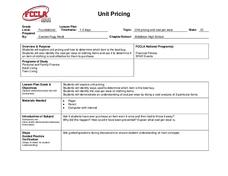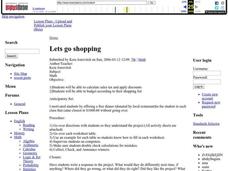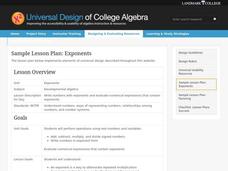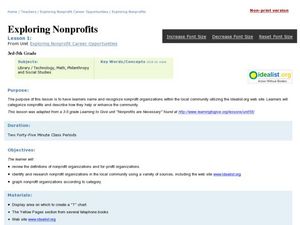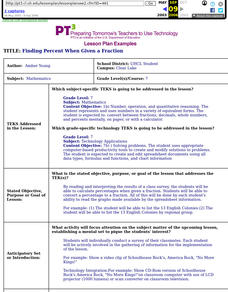Visa
Money Matters: Why It Pays to Be Financially Responsible
What does it mean to be financially responsible? Pupils begin to develop the building blocks of strong financial decision making by reviewing how their past purchases are examples of cost comparing, cost-benefit analysis, and budgeting.
K-5 Math Teaching Resources
Triangle Pack
With so many different types of triangles, it can be a challenge for young mathematicians to keep them all straight. Luckily this set of printable triangles is here to engage children in comparing and sorting triangles by their...
Curated OER
Thinking About Money
Students evaluate various approaches to spending money.In this spending money literacy lesson plan, students broaden their financial goals by reading "Alexander Who Used to Be Rich Last Sunday" and "A Chair for My Mother."Students use a...
Florida Center for Instructional Technology
Integrating Mathematics into Literature
You class will read Cucumber Soup by Vickie Leigh Krudwig as an anticipatory set for this lesson on ratios. They make models of the insects in the story and then use them as a source of data for this ratio and proportion lesson. This...
Curated OER
Introducing Multiplication
Learners will look at repeating addition examples and view how they can be written as multiplication. They use manipulatives to complete a repeating addition instructional activity and show it on graph paper. They also chart what they...
Census at School
Just How Old Are You?
Do you know how old you are in seconds, minutes, days, weeks, or months? This intriguing question is presented as a way for learners to estimate in units of time. They'll build a better sense of what each increment of time is as they...
Curated OER
Character Education: Perseverance
Sixth graders develop long term finance goals and understand why they are important. In this character education lesson, 6th graders compare the benefits of perseverance versus impulse spending. Students set five personal goals.
Curated OER
Unit Pricing
Students explore unit pricing to determine the best buy for their money. In this personal finance lesson, students calculate cost per wear examples and create a list of criteria for picking clothes. Students visit a story and use their...
Curated OER
Let's Go Shopping
Seventh graders calculate sales tax and apply discounts regarding a set budget. They create a shopping list, apply tax and discounts, complete a worksheet, and calculate their total cost to equal as close to $1000.00 as they can without...
Curated OER
St. Patrick’s Day
Combine math, creative writing, and leprechauns in a fun St. Patrick's Day activity! Using a bag of gold coins and marshmallows, kids write a math story about a leprechaun that includes a multi-step equation to solve.
Curated OER
Building Understanding of Rate of Change/Slopes Using Alice
Students explore slope as a rate of change. For this eighth grade mathematics lesson, students investigate real-world problems to determine rate of change and transform it into a linear representation, thus determining slope. Students...
Curated OER
Adding and Subtracting Algebraic Expressions (Combining Like Terms)
Everyone loves math when it includes food! This lesson tries to take the notion of combining like terms in algebra and comparing it to sorting apples and oranges. It takes a step-by-step approach to helping young scholars understand this...
Curated OER
Capacity: Gallon, Quart, Pint, Cup
Young measurers identify gallons, quarts, pints, and cups, then determine equivalent measurements for capacity using customary measuring tools.
PLS 3rd Learning
Complete Adjustment Column of a Worksheet
Accounting is a vital skill for personal finance management and when running a business. As part of a larger lesson plan, learners fill out the adjustments column of an accounting worksheet. They practice keeping records on a real...
Curated OER
Triangles
In this geometry worksheet, 10th graders solve problems involving triangular inequality. They apply the proofs and theorem of triangles to solve these problems. There is an overview and one question.
Curated OER
Exponents
Ninth graders solve problems involving exponential functions. In this algebra lesson, 9th graders apply their knowledge of exponential properties to add, multiply, divide and subtract exponential functions. They perform these operations...
Curated OER
Ants
Students make sequential patterns by using ants and following the model. They identify different parts of an ant by matching the picture to the word name. Pupils identify the ant's life cycle by creating a chart using pictures.
Curated OER
Non Profits Are Necessary
Students discuss the importance of nonprofit organizations. In this nonprofit lesson, students research nonprofit organizations online and study the nonprofits' impact on society.
Curated OER
Banking on Family
Students examine the meaning of a trust bank account. In this financial awareness lesson, students brainstorm ways they are trustworthy to their family and define the meaning of a trust bank account.
Curated OER
Buzzing is BEE-lieving
Students investigate insects. In this insect lesson, students explore various insect models and identify the characteristics of each. Students observe insects outside and tally how many insects they observe.
Curated OER
Solving Equations Using Two Operations
Need more detail in showing your class how to solve two-step equations and proportions? This lesson plan outlines the steps young mathematicians need to solve simple equations and check their results.
Curated OER
Ordinals
Learners examine uses for ordinal numbers in calendars, and an ordinal chart. They order ice cream cone cut outs from 1st to 20th and complete a worksheet. (not given)
Curated OER
Relating Division and Subtraction
Third graders relate the process of division to subtracting equal groups. Through guided practice and teacher demonstration, they complete division problems using a subtraction method. Students complete problems independently for...
Curated OER
Finding Percent When Given A Fraction
Seventh graders calculate percentages when given a fraction. They convert a percentage to a fraction. All of this be done by each student's ability to read the graphs made available by the spreadsheet information.







